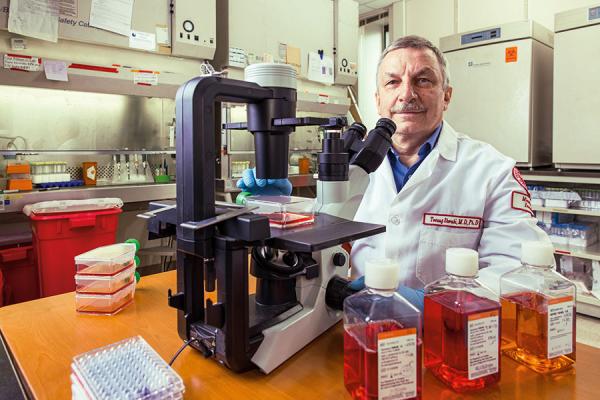Scientists have long known that leukemia cells accumulate a great deal of spontaneous DNA damage, far more than normal blood cells. Unfortunately, these cancer cells also have an uncanny ability to repair DNA damage and survive, so they can continue spreading throughout the body.
and survive, so they can continue spreading throughout the body.
But what if doctors were able to stop that self-repair process so that DNA-damaged leukemia cells simply died off on their own? That’s the goal of new research published recently by scientists at Fels Cancer Institute for Personalized Medicine at the Lewis Katz School of Medicine at Temple University and Fox Chase Cancer Center.
The findings could be used to develop new therapies against leukemia, treatments that use the cells’ own naturally occurring genetic damage against them, said Tomasz Skorski, MD, PhD, DSci, Director of the Fels Institute and Associate Director at Fox Chase. This approach could potentially be used to fight leukemia without the use of toxic chemotherapy drugs.
“If we identify the mechanism responsible for the repair and survival of spontaneous DNA damage in leukemia cells, we can target those pathways to eradicate the bad cells,” Skorski said. “At the same time, normal cells having less DNA damage will repair it using different mechanisms, so they will not be affected.”
For the study, researchers first sought to understand why leukemia cells had so much naturally occurring DNA damage. They knew that because leukemia cells replicate so quickly, they also have a supercharged metabolism. While this metabolic process gives the cells the nutrients and energy they need to grow, the researchers found it also produces a byproduct: formaldehyde. It was this formaldehyde that was interrupting replication of leukemia cells by crosslinking a protein to the DNA, resulting in potentially lethal DNA double-strand breaks.
Next, they looked at how the leukemia cells repaired this damage. They found that the malignant cells produce large quantities of a unique enzyme called DNA polymerase theta that repairs the DNA lesions caused by formaldehyde. “You can target this DNA polymerase theta and inhibit it to achieve a therapeutic effect,” Skorski said.
In a mouse model, the scientists found that these inhibitory drugs were effective against leukemia cells and did not produce major toxic side effects or secondary tumors as chemotherapy drugs often do.
However, Skorski said that only certain types of leukemia appear to be sensitive to these kinds of inhibitors. Researchers are now working to pinpoint which types could be candidates for this treatment. “It depends on the genetic makeup of the leukemia the patient has,” he said. “This is part of the personalized medicine approach.”
He added that clinical trials are already underway looking at DNA polymerase theta inhibitors to treat solid tumors. He hopes that his team’s findings could be used as a foundation for clinical trials in leukemia as well.
The multinational, multi-institutional study, “DNA Polymerase Theta Protects Leukemia Cells From Metabolic-Induced DNA Damage,” was published in the journal Blood.
